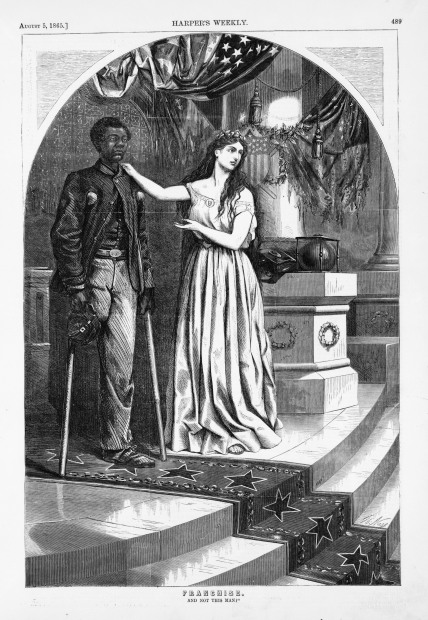
On March 8, 1979, Nast placed James G.Blaine front and center Harper’s cover with The Civilization of Blaine. A distinguished Blaine is seen at ground level receiving the attention of a subordinate, subservient African American. The black man’s posture is weak. Attired in country clothes, he crouches and cowers with a defensive grin on his face. He has the demeanor of a beaten dog approaching his master. He does not look the white politician in the eye. In his right hand, he clutches “A Vote” and offers this almost obediently to Blaine.

His right leg is drawn up, nervously rubbing the front of his right foot against the back of his left trouser, as if to polish it in the presence of greatness. Blaine’s left shoe tramples on the “Burlingame Treaty.”
As with most of Nast’s villains, Blaine’s face is not distorted or caricatured. Nast wanted him recognized and consistently depicted Blaine’s facial features realistically in his cartoons. Like Tweed, Nast rarely deviated from a famous face once it had been established as a character. His victim’s bodies, on the other hand, felt the weapon of distortion, but the face never!
In the background and elevated by a storefront step, a Chinese merchant emerges from his store. Nast assigns dignity to this merchant. Nast introduces him as a Chinese diplomat, often referred to as “John Confucius” or “John Chinaman” (the terms are interchangeable) in Nast’s cartoons. It is an important distinction to note, that in Nast’s catalog of images, he pulled from his personal supply of default or stock characters who served a specific purpose.
Some might argue that “John” perpetuates a stereotype. In almost every instance where John appears, he does so in the same manner as Columbia or Uncle Sam, figures in Nast cartoons who represent either a government or national virtues. They are figures, whom by their expression or stance, often provide admonition or displeasure to the scene of injustice they are witnessing. Nast could and did draw Chinese in any number of ways, and some of these are not flattering. “John Chinaman” or “John Confucius” never really changes. His inclusion is purposeful. He is Nast’s relied-upon figure of dignity and outrage toward injustice.
The merchant assumes the elevated position in the drawing. He is on the right, figuratively and morally. The injustice is on the left. The merchant is not shabbily dressed. Interestingly, his hair, though long, is not braided into the queue, which factors in most of Nast’s cartoons of the Chinese. It is a subtle change for Nast to utilize. John is wearing a hat, a crown if you will, a piece of clothing that imparts respect, formality, and distinction. This further validates his dual role as a local merchant and as a representative of the Chinese. His people will be affected by adherence to the treaty that Blaine is obligated, as a U.S. Senator, to protect. John’s arms are slightly outstretched as if encountering a surprise and ready to protest. At the right of his storefront is a sampling of the wares — the teas, silks, china and carvings that had been for years, favored art pieces of in Caucasian homes, bought and placed in homes “as signs of American aesthetic acumen and refinement” (Lenore-Chen 2).
Blaine senses the approach of John Confucius and waves him back with an extended left hand. Blaine’s face is slightly cocked, and his eyes avert to the left as the Chinese merchant approaches from behind. Blaine’s expression is clearly one that intends to discard the Chinese merchant completely, as if to say, “Stay where you are–do not interfere here.” Nast speaks for John Confucius (for his mouth is drawn shut) so the audience can ponder his question placed in the caption, “Am I not a Man and a Brother!”
The cartoon and caption echo an earlier post-Civil War illustration Nast had drawn to advocate on behalf of and provoke emotion for Negro suffrage. Nast’s 1865 illustration “And Not This Man? “shows Columbia resplendent in American symbolism, arguing for the admission of a wounded Negro Union soldier into the American family.
Nast’s experiences and other images he drew on behalf of civil rights had a cumulative and successful effect. “Nast’s sensitivity to the rights of minority Americans would extend to others besides the embattled freedmen” (Keller 107). Nast would never draw African Americans again with the same dignity as this early drawing. However, by evoking the same sentiment, this time on behalf of the Chinese, Nast might have hoped that his pen would wield influential once more on the national consciousness.
These aspirations were misplaced. With each election in the 1870’s, the Democratic Party gained inroads and influence, courting the votes and catering to the demands of a growing white, male labor force comprised of first and second- generation immigrants. “The loss of Republican purity was a loss of Republican power” (Keller 281). Politicians and public sentiment were drifting away from Nast. But Nast and Harper’s Weekly would not give up on minorities. “The Chinese and the Indians, in particular, came under his protective wing” (Keller 107).


4 thoughts on ““Civilization of Blaine” 1879”